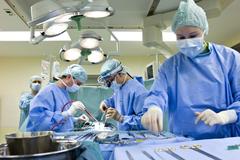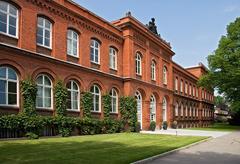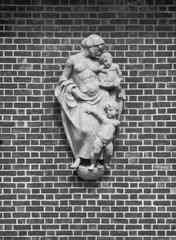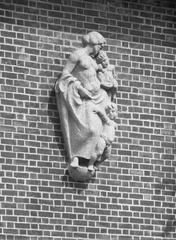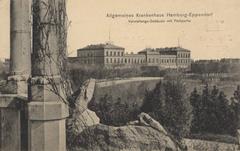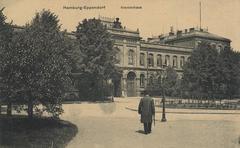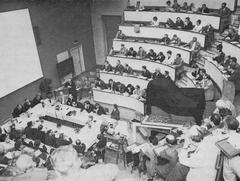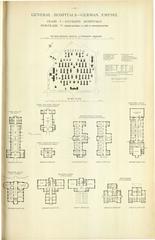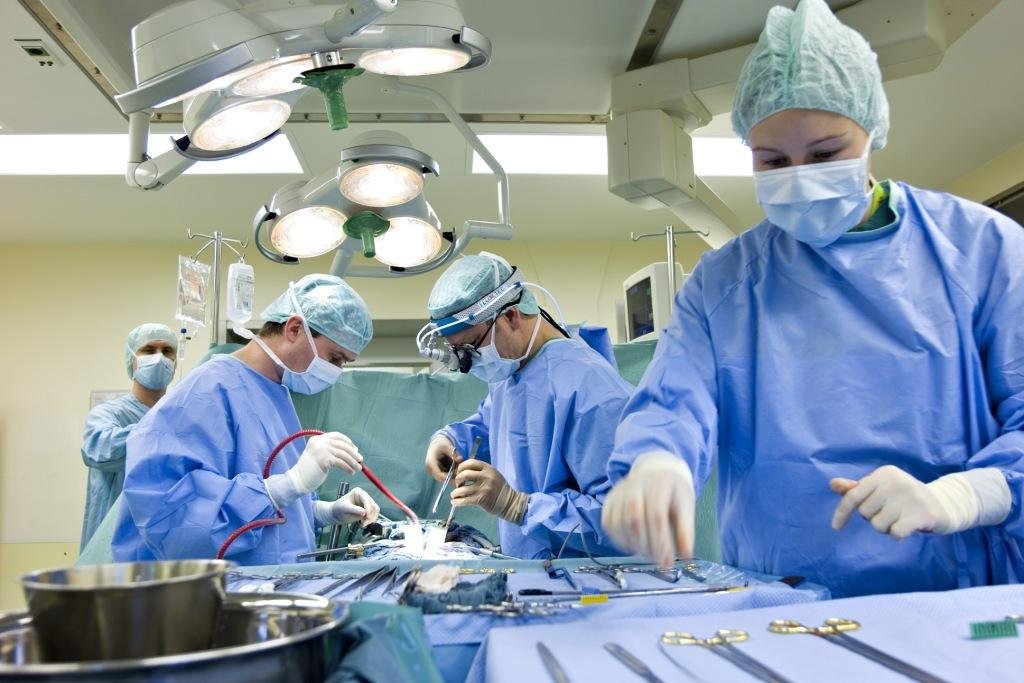
University Medical Center Hamburg-Eppendorf Visiting Hours, Tickets, and Guide to Hamburg Historical Sites
Date: 14/06/2025
Introduction: A Gateway to Medical Heritage and Hamburg’s History
The University Medical Center Hamburg-Eppendorf (UKE) is a landmark of German medical history and a modern hub of research and patient care. Founded in the early 20th century to address Hamburg’s urgent public health needs, UKE has developed into a leading institution renowned for its scientific, educational, and architectural significance. Its campus, designed by Fritz Schumacher between 1913 and 1926, is not only a testament to early 20th-century medical advancement but also serves as a living museum, inviting visitors to explore the intersection of history, architecture, and healthcare innovation.
Whether you are a medical professional, history enthusiast, or traveler interested in Hamburg’s cultural fabric, this guide provides comprehensive information about UKE’s visiting hours, ticketing, tours, accessibility, and tips for exploring nearby historical attractions. (UKE Medical Historic Museum; UKE Visitor Information)
Contents
- Introduction
- Historical Overview
- Founding and Early Development
- Scientific and Social Milestones
- UKE During the National Socialist Era
- Post-War Reconstruction and Modernization
- Medical Impact and Research Leadership
- Urban and Social Influence
- Preserving Medical Heritage
- Visitor Information
- Visiting Hours
- Tickets and Admission
- Guided Tours
- Accessibility
- Special Exhibitions and Events
- Photography and Interactive Experiences
- Directions and Nearby Attractions
- Frequently Asked Questions (FAQ)
- Conclusion and Travel Planning
- References
Historical Overview
Founding and Early Development
UKE was established in response to Hamburg’s public health crises in the late 19th and early 20th centuries, particularly recurring outbreaks of infectious diseases like cholera. Recognizing the need for a modern, research-oriented hospital, city officials commissioned Fritz Schumacher to design a facility that would integrate scientific progress with practical patient care. Construction began in 1913 and, despite the interruptions of World War I, the original complex was completed in 1926. Schumacher’s innovative layout included laboratories, lecture halls, dissecting rooms, and specialized research spaces—features that were groundbreaking for the era (UKE Medical Historic Museum).
Scientific and Social Milestones
From its earliest days, UKE was a leader in applying the latest scientific discoveries in cell biology, hygiene, and disease treatment. The hospital played a crucial role in public health reforms, including advancements in maternity care and infant welfare. Its influence extended beyond medicine, driving social initiatives that shaped Hamburg’s development as a city focused on health and education.
UKE During the National Socialist Era
The institution’s history during the 1930s and 1940s is addressed thoughtfully by the Medical Historic Museum. Exhibitions document the ethical challenges and the impact of National Socialism on medical practice, underscoring the importance of reflection and remembrance in the field of healthcare.
Post-War Reconstruction and Modernization
Following World War II, UKE underwent significant reconstruction, balancing modernization with the preservation of important historical spaces. The dissecting room from 1926 remains intact, thanks to the dedication of the Circle of Friends and the support of cultural heritage organizations.
Medical Impact and Research Leadership
Today, UKE is a preeminent university hospital affiliated with the University of Hamburg, hosting renowned centers such as the Universitäres Cancer Center Hamburg (UCCH). It collaborates with leading research institutes like the Centre for Structural Systems Biology (CSSB), utilizing state-of-the-art technologies for both patient care and scientific discovery.
Urban and Social Influence
UKE’s presence has profoundly shaped the Eppendorf district, fostering a vibrant environment for scientific and cultural exchange. Its ongoing “Zukunftsplan 2050” (Future Plan 2050) demonstrates a commitment to evolving healthcare delivery and urban integration.
Preserving Medical Heritage
A central highlight for visitors is the UKE Medical Historic Museum, housed in the original Schumacher building. The museum preserves and interprets the evolution of medical science through permanent and rotating exhibitions, with the preserved 1926 dissecting room as a focal point (UKE Medical Historic Museum).
Visitor Information
Visiting Hours
-
Medical Historic Museum:
Tuesday–Friday: 10:00 AM–4:00 PM
Saturday: 11:00 AM–3:00 PM
Closed Sunday and Monday
(UKE Medical Historic Museum) -
General Hospital Visiting:
Most wards: 2:00 PM–8:00 PM daily (check specific departments for variations)
(UKE Visitor Information)
Tickets and Admission
- Museum Admission: Free for all visitors, supporting accessible education and cultural engagement.
Guided Tours
- Museum Tours: Available by appointment for groups and individuals. These tours provide in-depth perspectives on exhibits, architecture, and the ethical dimensions of medical history. Advance booking is recommended through the museum or visitor center (UKE Visitor Information).
Accessibility
- The UKE campus and museum are fully wheelchair accessible. Additional assistance and accommodations can be arranged—contact the museum in advance to discuss any specific needs.
Special Exhibitions and Events
- The museum organizes special exhibitions focused on topics such as nursing, medical ethics, and the evolution of healthcare. Event schedules are posted on the official website and social media channels.
Photography and Interactive Experiences
- Photography is permitted in most areas of the museum, including the historic dissecting room. Flash and tripods may be restricted; consult staff for details. Interactive displays offer engaging educational experiences suitable for all ages.
Directions and Nearby Attractions
- Getting There: UKE is easily accessible via Hamburg’s U-Bahn and bus lines. The campus is well signposted, and detailed directions are available online (UKE Visitor Information).
- Nearby Sites: Explore the Eppendorf district’s cafes and shops, the Alster Lakes, the Speicherstadt warehouse district, and the Elbphilharmonie concert hall—all within convenient reach for a full day of cultural sightseeing.
Frequently Asked Questions (FAQ)
Q: What are the UKE Medical Historic Museum’s opening hours?
A: Tuesday–Friday, 10:00 AM–4:00 PM; Saturday, 11:00 AM–3:00 PM; closed Sunday and Monday.
Q: Is there an entry fee for the museum?
A: No, admission is free for all visitors.
Q: Can I arrange a guided tour?
A: Yes, tours are available by appointment. Contact the museum or visitor services for booking.
Q: Is the UKE campus accessible to visitors with disabilities?
A: Yes, the entire facility, including the museum, is wheelchair accessible. Contact ahead for special assistance.
Q: Are photographs allowed in the museum?
A: Yes, though some restrictions may apply (e.g., flash, tripods). Please check with staff upon arrival.
Conclusion and Travel Planning
The University Medical Center Hamburg-Eppendorf serves as both a historical landmark and a thriving center for modern medicine. Its Medical Historic Museum offers rare insights into the evolution of healthcare, from architectural innovation to pioneering research and ethical reflection. With free admission, accessible facilities, and engaging exhibitions, UKE is an essential stop for anyone exploring Hamburg’s rich tapestry of history, science, and culture.
Before your visit, check the official UKE website for up-to-date information on hours, special events, and tours. Consider downloading the Audiala app for guided audio tours, and follow UKE’s social media channels for the latest news and exhibition updates. Combine your UKE visit with nearby attractions in Eppendorf and the greater Hamburg area for a comprehensive and memorable experience (UKE Medical Historic Museum; UKE Visitor Information).
